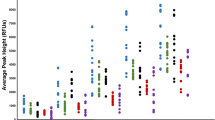Abstract
We report a pyrosequencing method for detecting a short amelogenin fragment to aid the gender identification. The PCR products (44/45 bp), including primers and target sequence (4/5 bp) consisting of three point mutations and one indel mutation, were sequenced by the pyrosequencing method. 100 randomly chosen DNA samples of healthy donors were analyzed with this method, and all of them were correctly typed. The sensitivity of the technique was 0.5 ng template DNA. No specific peak was found in any detected animals or organisms except for monkey. For blood samples that were left outside for 26 weeks and DNA degraded artificially by digesting with DNaseI, this method gave more accurate results than the conventional method. Moreover, four bone samples analyzed using the method gave clear pyrograph. This method is easy, quick, cheap and suitable for high-throughput analysis, especially for identifying the gender of highly-degraded DNA samples.






Similar content being viewed by others
Abbreviations
- PAGE:
-
Polyacrylamide gel electrophoresis
- PCR:
-
Polymerase chain reaction
- SNP:
-
Single nucleotide polymorphism
- STR:
-
Short tandem repeats
- AMEL:
-
Amelogenin
References
von Wurmb-Schwark N, Bosinski H, Ritz-Timme S (2007) What do the X and Y chromosomes tell us about sex and gender in forensic case analysis? J Forensic Leg Med 14(1):27–30
Birch L, English CA, O’Donoghue K, Barigye O, Fisk NM, Keer JT (2005) Accurate and robust quantification of circulating fetal and total DNA in maternal plasma from 5 to 41 weeks of gestation. Clin Chem 51(2):312–320
Honda H, Miharu N, Ohashi Y, Ohama K (2001) Successful diagnosis of fetal gender using conventional PCR analysis of maternal serum. Clin Chem 47(1):41–46
Robinson DO, Dalton P, Jacobs PA, Mosse K, Power MM, Skuse DH, Crolla JA (1999) A molecular and FISH analysis of structurally abnormal Y chromosomes in patients with Turner syndrome. J Med Genet 36(4):279–284
Tyler MG, Kirby LT, Wood S, Vernon S, Ferris JA (1986) Human blood stain identification and sex determination in dried blood stains using recombinant DNA techniques. Forensic Sci Int 31(4):267–272
Reynolds R, Varlaro J (1996) Gender determination of forensic samples using PCR amplification of ZFX/ZFY gene sequences. J Forensic Sci 41(2):279–286
Nakahori Y, Hamano K, Iwaya M, Nakagome Y (1991) Sex identification by polymerase chain reaction using X-Y homologous primer. Am J Med Genet 39(4):472–473. doi:10.1002/ajmg.1320390420
Akane A, Seki S, Shiono H, Nakamura H, Hasegawa M, Kagawa M, Matsubara K, Nakahori Y, Nagafuchi S, Nakagome Y (1992) Sex determination of forensic samples by dual PCR amplification of an X-Y homologous gene. Forensic Sci Int 52(2):143–148
Sullivan KM, Mannucci A, Kimpton CP, Gill P (1993) A rapid and quantitative DNA sex test: fluorescence-based PCR analysis of X-Y homologous gene amelogenin. Biotechniques 15(4):636–638; 640–641
Tschentscher F, Frey UH, Bajanowski T (2008) Amelogenin sex determination by pyrosequencing of short PCR products. Int J Legal Med 122(4):333–335. doi:10.1007/s00414-008-0228-4
Maciejewska A, Pawlowski R (2009) A rare mutation in the primer binding region of the Amelogenin X homologue gene. Forensic Sci Int Genet 3(4):265–267
Petrosino JF, Highlander S, Luna RA, Gibbs RA, Versalovic J (2009) Metagenomic pyrosequencing and microbial identification. Clin Chem 55(5):856–866
Bickmann JK, Kamin W, Wiebel M, Hauser F, Wenzel JJ, Neukirch C, Stuhrmann M, Lackner KJ, Rossmann H (2009) A novel approach to CFTR mutation testing by pyrosequencing-based assay panels adapted to ethnicities. Clin Chem 55(6):1083–1091
Pati N, Schowinsky V, Kokanovic O, Magnuson V, Ghosh S (2004) A comparison between SNaPshot, pyrosequencing, and biplex invader SNP genotyping methods: accuracy, cost, and throughput. J Biochem Biophys Methods 60(1):1–12. doi:10.1016/j.jbbm.2003.11.005
Karlsson AO, Holmlund G (2007) Identification of mammal species using species-specific DNA pyrosequencing. Forensic Sci Int 173(1):16–20
Castaldo I, Pinelli M, Monticelli A, Acquaviva F, Giacchetti M, Filla A, Sacchetti S, Keller S, Avvedimento VE, Chiariotti L, Cocozza S (2008) DNA methylation in intron 1 of the frataxin gene is related to GAA repeat length and age of onset in Friedreich ataxia patients. J Med Genet 45(12):808–812
Ensenberger MG, Thompson J, Hill B, Homick K, Kearney V, Mayntz-Press KA, Mazur P, McGuckian A, Myers J, Raley K, Raley SG, Rothove R, Wilson J, Wieczorek D, Fulmer PM, Storts DR, Krenke BE (2010) Developmental validation of the PowerPlex 16 HS System: an improved 16-locus fluorescent STR multiplex. Forensic Sci Int Genet 4(4):257–264
Butler JM, Shen Y, McCord BR (2003) The development of reduced size STR amplicons as tools for analysis of degraded DNA. J Forensic Sci 48(5):1054–1064
Chung DT, Drabek J, Opel KL, Butler JM, McCord BR (2004) A study on the effects of degradation and template concentration on the amplification efficiency of the STR Miniplex primer sets. J Forensic Sci 49(4):733–740
Gibbon V, Paximadis M, Strkalj G, Ruff P, Penny C (2009) Novel methods of molecular sex identification from skeletal tissue using the amelogenin gene. Forensic Sci Int Genet 3(2):74–79
Fondevila M, Phillips C, Naveran N, Fernandez L, Cerezo M, Salas A, Carracedo A, Lareu MV (2008) Case report: identification of skeletal remains using short-amplicon marker analysis of severely degraded DNA extracted from a decomposed and charred femur. Forensic Sci Int Genet 2(3):212–218
Acknowledgments
We thank Lei Zhao, Xue Bai for their support on bone DNA extraction techniques, and Bangxian Dou, Jixing Zhu for their support on Bone samples supply. This study was supported by National Natural Science Foundation of China (30973364) and Natural Science Foundation of Hebei Province (C2010000459).
Author information
Authors and Affiliations
Corresponding author
Additional information
Shujin Li and Ting Feng contributed equally to this work.
Rights and permissions
About this article
Cite this article
Li, S., Feng, T., Fu, L. et al. Pyrosequencing of a short fragment of the amelogenin gene for gender identification. Mol Biol Rep 39, 6949–6957 (2012). https://doi.org/10.1007/s11033-012-1522-2
Received:
Accepted:
Published:
Issue Date:
DOI: https://doi.org/10.1007/s11033-012-1522-2




